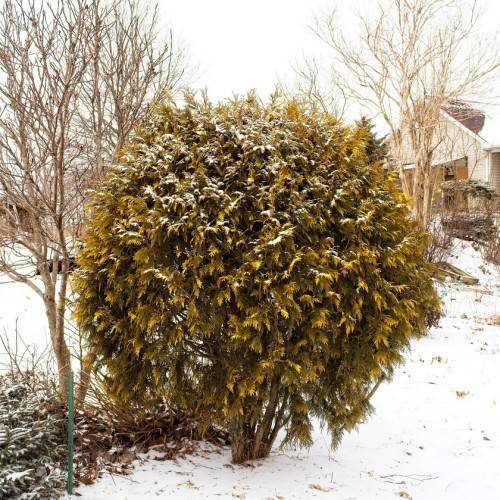
American arborvitae
Thuja occidentalis 'Golden Globe'
Cycle:
Perennial
Watering:
Frequent
Hardiness Zone:
2 - 7
Flowers:
Flowers In Spring
Sun:
Full sun, Part sun/part shade
Soil:
Sandy Loamy Clay Rocky
Cones:
Yes
Leaf:
Yes
Growth Rate:
Moderate
Maintenance:
Low
Drought Tolerant:
Yes
Care Level:
Low
watering
American arborvitae (Thuja occidentalis 'Golden Globe') is a hardy evergreen plant that requires regular watering to remain healthy. The amount of water and frequency of watering depends on its planting location, season, and the soil type. In general during the spring and summer months, water deeply and thoroughly twice a week. Water in the morning or early evening when temperatures are cool. On hot summer days, this species may benefit from being watered a third time. If temperatures stay consistently over 90°F, increase the frequency of watering until the weather cools off. During the fall and winter seasons, water only when the top inch of soil is dry. Be sure to check the soil moisture before watering as this plant is prone to root rot if overwatered. Look for signs like yellowing leaves or wilting of the foliage which may indicate over-watering. Regular check-ups and appropriate waterings will maintain the health of this species and keep it looking great!
sunlight
American arborvitae (Thuja occidentalis 'Golden Globe') should receive 4-6 hours of yard sunlight or equivalent every day. The best time for sunlight is 8-10am in the morning before midday, where the intensity of the sun is not overwhelming, as this tree species is best suited for mild sun. It is important to also note that during the summer months extra care should be taken to avoid intense hot sun exposure from midday through late afternoon, as this could damage and limit the growth of this species.
pruning
American arborvitae (Thuja occidentalis 'Golden Globe') should be pruned once a year in late winter or early spring. Pruning should be done to promote growth and maintain a uniform globe shape. When pruning, remove only a third of the branches at their base. Make sure to prune branches that are dead, unhealthy, or too tall. Additionally, cutting away any of the small, fast-growing, vertical branches and selectively thinning the foliage can also help maintain the globe shape. Care should also be taken not to prune too much at once, as it can stress the plant.
